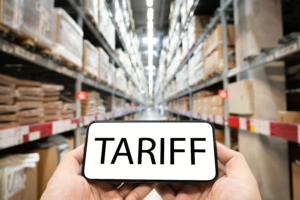
Who would have thought a term like “supply chain”, traditionally reserved for business and boardroom discussions, would become a topic du jour with the average consumer? It has–and not because it’s an overly compelling topic. “Supply chain” is now part of our everyday dialogue because almost everyone felt the impact of interruptions when the pandemic hit. When the grocery store was out of paper towels, shoppers were quick to say to one another, “It’s the supply chain again!”
The global supply chain disruption that started with the pandemic is still being felt today, and the notion that we need a sustainable supply chain strategy is up for debate. Every company knows that without one, they’re not going to operate efficiently, or even profitably. What is up for discussion is how that type of supply chain strategy can be developed.
Sustainable Supply Chain Goals
Sustainability in how items and materials are created, distributed, and sold carries a number of attributes. As a first order of measure, what’s sustainable in one industry may be different in another, so the definition must make sense for your industry. Industry alignment aside, achieving a sustainable pipeline also requires a plan for execution, flexibility and responsiveness to unplanned events, built-in awareness for those circumstances when human intervention is needed, and ability to maintain the supply chain at a cost that is reasonable for your organization.
Typically, a sustainable supply chain consists of efficient supply chain strategy and responsive supply chain strategy.
Efficient vs Responsive Supply Chain Strategy
An efficient supply chain strategy focuses on optimizing every resource to deliver products to your customers. The goal is to minimize costs and maximize profits.
An efficient supply chain strategy would work for large corporations that:
- Are preferred vendors, meaning that they are the last company affected by supply chain interruptions.
- Can predict source and lead times and sales cycles.
- Have set transportation and logistics operations, typically pre-booking transportation in advance and using robotic picking.
If the factors that impact a supply chain are all predictable, similar to OEM suppliers, then having a laser focus on efficiency makes sense. However, there are very few companies that fit that mold.
Most manufacturers and distributors must strive for and incorporate a responsive supply chain strategy. A responsive supply chain strategy focuses on being flexible enough to scale up or down virtually all components of a chain. Managing a responsive supply chain requires more communications and interactivity because as some components are modified, that change is felt all along the chain. You can set rules to govern your responses: for example, if lead times increase 4%, no action may be necessary. But, if lead times increase 10%, a responsive supply chain will notify you that action is required, some of which can be pre-determined.
Challenges of Optimizing Your Supply Chain
There is a cost to operating optimally and being responsive, but the more you can automate the management of the supply chain, the less costly maintaining a responsive supply chain will be. To be competitive today, an organization needs to be continuously reviewing all the components of a supply chain and have predetermined options for speeding up, slowing down, expediting, sourcing, and adjusting transportation and logistics issues.
Data-backed decisions should trigger automatic reactions to the next change in the supply chain. Anything outside a level of pre-determined automatic adjustments needs to trigger alerts so that exception management techniques can be deployed. The ultimate application of technology in this space would be Artificial Intelligence (AI). The technology is there, but for most companies the data that is needed is not configured to readily solve their supply chain challenges.
The best sustainable supply chain strategies are a combination of efficient and responsive components. You must have an efficient strategy that can operate in most situations and a plan for how you will manage deviations to that strategy. You must decide how responsive you want and can afford to be.
Preparing to Build a Sustainable Supply Chain Strategy
As you evolve towards a sustainable supply chain, optimally, you’ll begin with an efficient supply chain strategy. You’ll know that timing is right to shift into a responsive strategy when disruption to your efficiency has occurred and you need to intervene. Here are some key steps to follow to make the intervention as smooth as possible.
1. Understand your customers. Complete a customer stratification analysis to make it easy to determine how to prioritize customer needs when something goes wrong.
2. Evaluate your items from multiple perspectives to identify those that are critical. Determine which items should be prioritized based on factors that can include gross margin, the importance of the customer to your organization, and the importance of the item to your customer. Completing an item stratification analysis will give you these answers.
3. Establish pre-negotiated deals with secondary suppliers. When you establish relationships with secondary suppliers, you’ll be in a much better position to get a response from them in an emergency. In addition, you’re not trying to negotiate terms at the last minute. Depending on your state of automation, you may even be able to automate a switch from one vendor to another.
There is also the question about whether a segmented product line strategy lends itself better than a single product line to sustainability in the supply chain. On the one hand, order fulfillment in a single product line strategy can be more challenging when disruption occurs. On the other, NAW has stated that segmented product lines contribute to disruption.
During this latest supply chain disruption, vendors with segmented product lines carried too many variations of essentially the same product, which skewed the measure of true demand. Vendors were prioritizing goods that were more aligned to fringe markets than core market demand. When the pandemic hit, sellers didn’t have enough of the true core products in stock and were left with what turned out to be the fringe products.
In the final analysis, segmented product lines don’t provide an automatic buffer against disruption and companies need to lay the groundwork in both product line scenarios for sustainable supply chain strategy so that when and if disruption does occur, you’ll be ready. Laying that groundwork requires the following to be considered:
1. Determine which customers will be affected. It’s much easier to find more items than it is to attract more customers. If you have stratified or modeled your customers, you’ll already have a priority order for how you need to approach satisfying the affected customers.
2. Communicate with your customers as quickly as possible. Transparency is an important policy when something goes wrong. When contacting your customers, you will undoubtedly find that some will be desperate to have their items delivered on time, and others will be able to accept a partial delivery with the balance arriving at a specified time.
3. Implement alternative plans for dealing with the disruption. You may need to move from your main transportation vendor to your secondary transportation vendor. You may need to move to a secondary item vendor. These rules and procedures for alternatives would have been identified and put in place when preparing to be more responsive.
Final Thoughts
In most industries, significant improvements to supply chains can be achieved in 3-4 months. It’s a fact that you will never be able to solve every problem up front, but you can make tangible improvements.
If you want to maintain your competitive advantage, developing an efficient and responsive supply chain strategy is a requirement. Your competitors are working on the same thing, and it makes a huge impact on the customer satisfaction you can provide.








